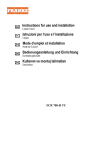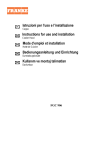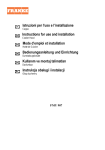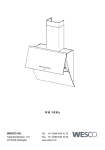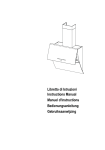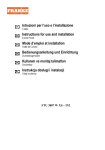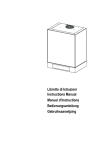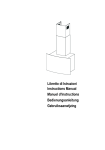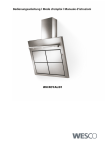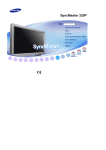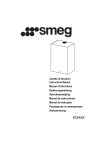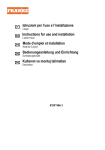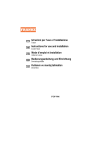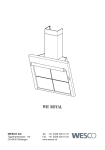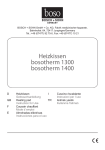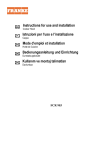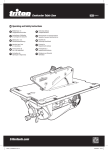Download Planar FPL606-PWXS FR(1.70 MB, PDF)
Transcript
GB IT Instructions for use and installation Cooker Hood Istruzioni per l’uso e l’installazione Cappa FR Mode d’emploi et installation DE Bedienungsanleitung und Einrichtung TR Kullanım ve montaj talimatları PL Instrukcja obsługi i instalacji Hotte de Cuisine Dunstabzugshaube Davlumbaz Okap kuchenny FPL 606 FPL 906 INDEX EN RECOMMENDATIONS AND SUGGESTIONS ......................................................................................................................3 CHARACTERISTICS..............................................................................................................................................................4 INSTALLATION ......................................................................................................................................................................5 USE.........................................................................................................................................................................................8 MAINTENANCE......................................................................................................................................................................9 INDICE IT CONSIGLI E SUGGERIMENTI ............................................................................................................................................11 CARATTERISTICHE ............................................................................................................................................................12 INSTALLAZIONE..................................................................................................................................................................13 USO ......................................................................................................................................................................................16 MANUTENZIONE .................................................................................................................................................................17 SOMMAIRE FR CONSEILS ET SUGGESTIONS ..........................................................................................................................................19 CARACTERISTIQUES .........................................................................................................................................................20 INSTALLATION ....................................................................................................................................................................21 UTILISATION........................................................................................................................................................................24 ENTRETIEN..........................................................................................................................................................................25 INHALTSVERZEICHNIS DE EMPFEHLUNGEN UND HINWEISE....................................................................................................................................27 CHARAKTERISTIKEN..........................................................................................................................................................28 MONTAGE............................................................................................................................................................................29 BEDIENUNG.........................................................................................................................................................................32 WARTUNG............................................................................................................................................................................33 IÇERIKLER TR TAVSIYELER VE ÖNERILER ..............................................................................................................................................35 ÖZELLIKLER ........................................................................................................................................................................36 MONTAJ ...............................................................................................................................................................................37 KULLANIM ............................................................................................................................................................................40 BAKIM...................................................................................................................................................................................41 SPIS TREŚCI PL UWAGI I SUGESTIE.............................................................................................................................................................43 WŁAŚCIWOŚCI TECHNICZNE............................................................................................................................................44 INSTALACJA ........................................................................................................................................................................45 UŻYTKOWANIE....................................................................................................................................................................48 KONSERWACJA ..................................................................................................................................................................49 2 2 RECOMMENDATIONS AND SUGGESTIONS The Instructions for Use apply to several versions of this appliance. Accordingly, you may find descriptions of individual features that do not apply to your specific appliance. INSTALLATION • The manufacturer will not be held liable for any damages resulting from incorrect or improper installation. • The minimum safety distance between the cooker top and the extractor hood is 550 mm. • Check that the mains voltage corresponds to that indicated on the rating plate fixed to the inside of the hood. • For Class I appliances, check that the domestic power supply guarantees adequate earthing. Connect the extractor to the exhaust flue through a pipe of minimum diameter 120 mm. The route of the flue must be as short as possible. • Do not connect the extractor hood to exhaust ducts carrying combustion fumes (boilers, fireplaces, etc.). • If the extractor is used in conjunction with non-electrical appliances (e.g. gas burning appliances), a sufficient degree of aeration must be guaranteed in the room in order to prevent the backflow of exhaust gas. The kitchen must have an opening communicating directly with the open air in order to guarantee the entry of clean air. USE • The extractor hood has been designed exclusively for domestic use to eliminate kitchen smells. • Never use the hood for purposes other than for which it has ben designed. • Never leave high naked flames under the hood when it is in operation. • Adjust the flame intensity to direct it onto the bottom of the pan only, making sure that it does not engulf the sides. • Deep fat fryers must be continuously monitored during use: overheated oil can burst into flames. • Do not flambè under the range hood; risk of fire • This appliance is not intended for use by persons (including children) with reduced physical, sensory or mental capabilities, or lack of experience and knowledge, unless they have been given supervision or instruction concerning use of the appliance by a person responsible for their safety. • Children should be supervised to ensure that they do not play with the appliance. 550 mm min. MAINTENANCE • Switch off or unplug the appliance from the mains supply before carrying out any maintenance work. • Clean and/or replace the Filters after the specified time period. • Clean the hood using a damp cloth and a neutral liquid detergent. The symbol on the product or on its packaging indicates that this product may not be treated as household waste. Instead it shall be handed over to the applicable collection point for the recycling of electrical and electronic equipment. By ensuring this product is disposed of correctly, you will help prevent potential negative consequences for the environment and human health, which could otherwise be caused by inappropriate waste handling of this product. For more detailed information about recycling of this product, please contact your local city office, your household waste disposal service or the shop where you purchased the product. EN 3 3 CHARACTERISTICS Dimensions Components Ref. 1 7 8 9 10 Q.ty Product components 1 Hood Body complete with: Controls, Light, Suction Unit, Filters, Lower Duct 1 PVC Pipe (fitted) 1 Inclinable grid (fitted) 1 Reduction flange ø 150-120 mm 1 Metal cover Ref. 11a Q.ty Assembly components 2 SB 12/10 Plugs 10 8 11a 7 9 Q.ty Documents 1 Instruction Manual EN 4 4 INSTALLATION Boring the wall If you want to use the hood in suction version with the air outlet at the back of the hood, make sure to follow the indications given below in the drawing for a correct boring operation of the air outlet opening. Hood type X 45 180 90 390 X 11a Rear air outlet zone 550 mm min 540 250 808 300 X 60 240 When installing the hood in recycling version it has to be taken into consideration that space remaining between the hood and the upper limit (ceiling or self) is at least 8-10 cm. On the wall, trace: • a vertical line up to the ceiling or top limit, at the centre of the area where you intend to fit the hood; • a horizontal line at: 550 mm min. above the cooking hob; • As shown, mark a reference point at 808 mm above the horizontal reference line, and at X mm (X= see table in figure) to the right of the vertical reference line. • Repeat this operation on the opposite side, checking levelling. • Drill the points marked using a ø 12 mm bit • Insert plugs with screws and brackets 11a in the holes then tighten them. EN 5 5 Hood body assembly 11a • Adjust the two screws Vr of brackets 11a, by just placing them in position. • Hook the hood body to the two brackets 11a. • Pull the Comfort Panel to open it, remove the filters one by one, push them towards the rear part of the unit and pull downwards at the same time . • From inside the hood body, tighten the screws Vr to level the body. Vr Connection AIR OUTLET IN A DUCTING HOOD VERSION When installing the hood in ducting version, basing on the installer’s choice, a rigid or a flexible pipe with a ø 150 or 120 mm is used in order to connect the hood to the air outlet piping. The pipe connection can be made on the upper part or on the rear side of the hood. Before connecting the hood to the air outlet ducting remove the lateral air outlet grid 8 and the plastic tube 7. The adapting flange 9 has to be removed only in case the connecting diameter is 150. ø 150 9 ø 120 REAR AIR OUTLET • When drilling the air outlet hole in the wall proceed in accordance with the scheme in the part concerning the wall drilling. • Use a pair of tongs when breaking the rear air outlet hole in the wall. • In case the connection is made by using a ø 120 mm pipe insert the reduction flange 9 on the hood body outlet. • Fix the pipe with an adequate quantity of pipe clamps. This material is not supplied together with the hood. • Remove the charcoal filter if present. • Fix the metal cover 10 to the upper air outlet hole of the hood by using the screws supplied. UPPER AIR OUTLET • In case the connection is made by using a ø 120 mm pipe insert the reduction flange 9 on the hood body outlet. • Use a pair of tongs when removing the central part of the metal cover 10. Fix the cover to the air outlet hole of the hood by using the screws supplied. • Fix the pipe with an adequate quantity of pipe clamps. This material is not supplied together with the hood. • Remove the charcoal filter if present. EN 10 10 6 6 AIR OUTLET IN A RECYCLING HOOD VERSION • In case the components requested for the recycling functioning have been removed earlier these have to be positioned again. • Put the plastic tube onto the flange 7. • Place the air outlet grid 8 on the air outlet. Make sure that the position of the grid is correct. • Make sure that charcoal filters have been placed inside the hood. 8 7 ELECTRICAL CONNECTION • Connect the hood to the mains through a two-pole switch having a contact gap of at least 3 mm. • Remove the grease filters (see paragraph Maintenance) being sure that the connector of the feeding cable is correctly inserted in the socket placed on the side of the fan. EN 7 7 USE T1 T2 T4 T3 T5 L Control panel TOUCH CONTROL T1 ON/OFF Motor T2 T3 T4 Speed Speed + Intensive speed T5 Delay L Lighting EN FUNCTION Switches the hood motor on and off. The latest selected speed appears on the display. Decreases the suction speed: V3 → V2 → V1 Increases the suction speed: V1 → V2 → V3 Activates the intensive speed from any previously selected speed. The intensive speed can be activated even when the motor is OFF. By pressing the same touch control once again or by switching off the motor this function can be deactivated. Intensive speed cannot be activated when the delay function is on. Intensive speed has been timed at 10 minutes: H appears on the display and a spot down on the right side flashes once a second. After 10 minutes the system activates automatically the latest selected speed. Activates and deactivates the delayed shutdown of the hood (motor + lighting) at 30 minutes: the selected speed of the hood appears on the display and a spot down on the right side flashes once a second. By pressing the same touch control once again or by switching off the motor delay function can be deactivated. Turns light on and off. 8 8 MAINTENANCE REMOTE CONTROL (OPTIONAL) The appliance can be controlled using a remote control powered by a 1.5 V carbon-zinc alkaline batteries of the standard LR03AAA type. • Do not place the remote control near to heat sources. • Used batteries must be disposed of in the proper manner. Cleaning the Comfort Panels • Pull the Comfort Panel to open it. • Disconnect the panel from the hood canopy by sliding the fixing pin lever. • The comfort panel must never be washed in a dishwasher. • Clean the outside using a damp cloth and neutral liquid detergent. • Clean the inside as well using a damp cloth and neutral detergent; do not use wet cloths or sponges, or jets of water; do not use abrasive substances. • When the above operation has been completed, hook the panel back to the hood canopy and close it by turning the knob in the opposite direction. EN 9 9 Grease filters CLEANING METAL SELF- SUPPORTING GREASE FILTERS • The filters must be cleaned every 2 months of operation, or more frequently for particularly heavy usage, and can be washed in a dishwasher. • Remove the filters one at a time by pushing them towards the back of the group and pulling down at the same time. • Wash the filters, taking care not to bend them. Allow them to dry before refitting. • When refitting the filters, make sure that the handle is visible on the outside. Activated charcoal filter (Recirculation version) These filters are not washable and cannot be regenerated, and must be replaced approximately every 4 months of operation, or more frequently with heavy usage. REPLACING THE ACTIVATED CHARCOAL FILTER • • • • Remove the metal grease filters Remove the saturated activated charcoal filter as shown (A). Fit the new filters (B). Replace the metal grease filters. B A Lighting LIGHT REPLACEMENT 20 W halogen light. • Remove the snap-on lamp cover by levering it from under the metal ring, supporting it with one hand. • Remove the halogen lamp from the lamp holder by pulling gently. • Replace the lamp with a new one of the same type, making sure that you insert the two pins properly into the housings on the lamp holder. • Replace the snap-on lamp cover. EN 1 10 0 CONSIGLI E SUGGERIMENTI Questo libretto di istruzioni per l'uso è previsto per più versioni dell' apparecchio. É possibile che siano descritti singoli particolari della dotazione, che non riguardano il Vostro apparecchio. INSTALLAZIONE • Il produttore declina qualsiasi responsabilità per danni dovuti ad installazione non corretta o non conforme alle regole dell’arte. • La distanza minima di sicurezza tra il Piano di cottura e la Cappa deve essere di 550 mm. • Verificare che la tensione di rete corrisponda a quella riportata nella targhetta posta all’interno della Cappa. • Per Apparecchi in Classe Ia accertarsi che l’impianto elettrico domestico garantisca un corretto scarico a terra. • Collegare la Cappa all’uscita dell’aria aspirata con tubazione di diametro pari o superiore a 120 mm. Il percorso della tubazione deve essere il più breve possibile. • Non collegare la Cappa a condotti di scarico dei fumi prodotti da combustione (caldaie, caminetti, ecc.). • Nel caso in cui nella stanza vengano utilizzati sia la Cappa che apparecchi non azionati da energia elettrica (ad esempio apparecchi utilizzatori di gas), si deve provvedere ad una aerazione sufficiente dell’ambiente. Se la cucina ne fosse sprovvista, praticare un’apertura che comunichi con l’esterno, per garantire il richiamo d’aria pulita. USO • La Cappa è stata progettata esclusivamente per uso domestico, per abbattere gli odori della cucina. • Non fare mai uso improprio della Cappa. • Non lasciare fiamme libere a forte intensità sotto la Cappa in funzione. • Regolare sempre le fiamme in modo da evitare una evidente fuoriuscita laterale delle stesse rispetto al fondo delle pentole. • Controllare le friggitrici durante l’uso: l’olio surriscaldato potrebbe infiammarsi. • Non preparare alimenti flambè sotto la cappa da cucina; pericolo d'incendio. • Questo apparecchio non deve essere utilizzato da persone (bambini inclusi) con ridotte capacità psichiche, sensoriali o mentali, oppure da persone senza esperienza e conoscenza, a meno che non siano controllati o istruiti all’uso dell’apparecchio da persone responsabili della loro sicurezza. • I bambini devono essere supervisionati per assicurarsi che non giochino con l’apparecchio. 550 mm min. MANUTENZIONE • Prima di procedere a qualsiasi operazione di manutenzione, disinserire la Cappa togliendo la spina elettrica o spegnendo l’interruttore generale. • Effettuare una scrupolosa e tempestiva manutenzione dei Filtri secondo gli intervalli consigliati. • Per la pulizia delle superfici della Cappa è sufficiente utilizzare un panno umido e detersivo liquido neutro. Il simbolo sul prodotto o sulla confezione indica che il prodotto non deve essere considerato come un normale rifiuto domestico, ma deve essere portato nel punto di raccolta appropriato per il riciclaggio di apparecchiature elettriche ed elettroniche. Provvedendo a smaltire questo prodotto in modo appropriato, si contribuisce a evitare potenziali conseguenze negative per l’ambiente e per la salute, che potrebbero derivare da uno smaltimento inadeguato del prodotto. Per informazioni più dettagliate sul riciclaggio di questo prodotto, contattare l’ufficio comunale, il servizio locale di smaltimento rifiuti o il negozio in cui è stato acquistato il prodotto. IT 1 11 1 CARATTERISTICHE Ingombro Componenti Rif. 1 7 8 9 10 Q.tà Componenti di Prodotto 1 Corpo Cappa completo di: Comandi, Luce, Gruppo Ventilatore, Filtri, Camino Inferiore 1 Tubo PVC (Installato) 1 Griglia direzionata (Installata) 1 Flangia di Riduzione ø 150-120 mm 1 Tappo Rif. 11a Q.tà Componenti di Installazione 2 Tasselli SB 12/10 10 8 11a 7 9 Q.tà Documentazione 1 Libretto Istruzioni IT 1 12 2 INSTALLAZIONE Foratura Parete Qualora si voglia collegare la cappa in versione aspirante, facendo uscire il tubo sulla parte posteriore, si ricorda che il foro di evacuazione dell’aria deve essere fatto seguendo le indicazione di seguito riportate nel disegno. Tipo Cappa X 45 180 90 390 X 11a Zona uscita aria posteriore 550 mm min 540 250 808 300 X 60 240 Nel caso di installazione della cappa in versione filtrante, tenere in considerazione che, sopra la cappa, deve rimanere una distanza dal limite superiore (Soffitto o Mensola) di almeno 8-10 Cm. Tracciare sulla Parete: • una linea Verticale fino al soffitto o al limite superiore, al centro della zona prevista per il montaggio della Cappa; • una linea Orizzontale a: 550 mm min. sopra il Piano di Cottura; • Segnare come indicato, un punto di riferimento a 808 mm sopra la linea orizzontale di riferimento, e a X mm (X = vedi tabella nell’illustrazione) sulla destra della linea verticale di riferimento. • Ripetere questa operazione dalla parte opposta, verificandone il livellamento. • Forare ø 12 mm i punti segnati. • Inserire i tasselli con vite e staffa 11a nei fori, avvitare. IT 1 13 3 11a Montaggio Corpo Cappa • Regolare le due viti Vr, delle staffe 11a, ad inizio corsa. • Agganciare il corpo cappa alle 2 staffe 11a. • Aprire il Comfort Panel tirandolo, togliere i Filtri uno alla volta, spingendoli verso la parte posteriore del gruppo e tirando contemporaneamente verso il basso. • Dall’interno del corpo cappa agire sulle Viti Vr per livellare il Corpo Cappa. Vr Connessioni USCITA ARIA VERSIONE ASPIRANTE Per installazione in Versione Aspirante collegare la Cappa alla tubazione di uscita per mezzo di un tubo rigido o flessibile di ø 150 o 120 mm, la cui scelta è lasciata all'installatore. Il tubo può uscire sia dalla parte superiore che posteriore della cappa. ø 150 Prima di procedere alle connessioni aspiranti rimuovere, qualora non sia già stato fatto, la griglia direzionata 8 e il tubo in pvc 7. La flangia di riduzione 9 va rimossa solo per effettuare collegamenti da ø 150. 9 ø 120 10 USCITA POSTERIORE • Si ricorda che per effettuare il foro di evacuazione va seguito lo schema riportato nel paragrafo foratura parete. • Rompere il foro di uscita posteriore con l’ausilio di una pinza. • Per collegamento con tubo ø120 mm, inserire la Flangia di riduzione 9 sull'Uscita del Corpo Cappa. • Fissare il tubo con adeguate fascette stringitubo. Il materiale occorrente non è in dotazione. • Togliere eventuali Filtri Antiodore al Carbone attivo. • Fissare il Tappo 10 sull’Uscita Superiore della Cappa con le Viti in dotazione. USCITA SUPERIORE • Per collegamento con tubo ø120 mm, inserire la Flangia di riduzione 9 sull'Uscita del Corpo Cappa. • Rimuovere la parte centrale del Tappo 10 con l’ausilio di una pinza e fissarlo sull’Uscita Superiore della Cappa con le Viti in dotazione. • Fissare il tubo con adeguate fascette stringitubo. Il materiale occorrente non è in dotazione. • Togliere eventuali Filtri Antiodore al Carbone attivo. IT 10 1 14 4 USCITA ARIA VERSIONE FILTRANTE • Qualora fossero stati rimossi riposizionare i componenti per versione filtrante già installati. • Inserire il tubo in pvc 7 sulla Flangia. • Riavvitare la Griglia direzionata 8 sull’uscita dell’aria, facendo attenzione che sia posizionata correttamente sul tubo. • Assicurarsi della presenza dei Filtri antiodore al Carbone attivo. 8 7 CONNESSIONE ELETTRICA • Collegare la Cappa all’Alimentazione di Rete interponendo un Interruttore bipolare con apertura dei contatti di almeno 3 mm. • Rimuovere i Filtri antigrasso (vedi par. “Manutenzione”) e assicurarsi che il connettore del Cavo di alimentazione sia correttamente inserito nella presa dell’Aspiratore IT 1 15 5 USO T1 T2 T4 T3 T5 L Quadro Comandi T1 TASTO ON/OFF Motore T2 T3 T4 Velocità Velocità + Velocità intensiva T5 Delay L Luci IT FUNZIONI Attiva e arresta il motore d’aspirazione. Sul display viene visualizzato lo step di velocità precedentemente impostata. Decrementa la velocità del motore: V3 →V2 → V1 Incrementa la velocità del motore: V1→V2→ V3 Attiva la velocità intensiva da qualsiasi velocità o da motore spento.Per disinserirla basta premere di nuovo lo stesso tasto o spegnere il motore. L’intensiva non è attivabile se è attiva la funzione Delay. La velocità intensiva è temporizzata a 10 minuti: sul display viene visualizzato H e il punto in basso a destra lampeggia una volta al secondo. Al termine dei 10 minuti il sistema torna automaticamente alla velocità precedentemente impostata. Attiva e disattiva la modalità di arresto totale della cappa (motore+luci) dopo 30 minuti: il display visualizza la velocità del motore e il punto in basso a destra lampeggia una volta al secondo. Per disabilitare il Delay si può ripremere lo stesso tasto oppure spegnere il motore Accende e spegne le luci della cappa. 1 16 6 MANUTENZIONE TELECOMANDO (OPZIONALE) Questo apparecchio può essere comandato per mezzo di un telecomando, alimentato con pile alcaline zinco-carbone da 1,5 V del tipo standard LR03-AAA. • Non riporre il telecomando in prossimità di fonti di calore. • Non disperdere le pile nell’ambiente, depositarle negli appositi contenitori. Pulizia dei Comfort Panel • Aprire il Comfort Panel tirandolo. • Sganciare il pannello dal corpo cappa facendo scorrere l’apposita leva del perno di fissaggio. • Il comfort panel non va assolutamente lavato in lavastoviglie. • Pulirlo esternamente con un panno umido e detersivo liquido neutro. • Pulirlo anche internamente utilizzando un panno umido e detergente neutro; non utilizzare panni o spugne bagnate, né getti d’acqua; non utilizzare sostanze abrasive. • Ad operazione ultimata riagganciare il pannello al corpo cappa e richiuderlo. . IT 1 17 7 Filtri antigrasso PULIZIA FILTRI ANTIGRASSO METALLICI AUTOPORTANTI • Sono lavabili anche in lavastoviglie, e necessitano di essere lavati ogni 2 mesi circa di utilizzo o più frequentemente, per un uso particolarmente intenso. • Togliere i Filtri uno alla volta, spingendoli verso la parte posteriore del gruppo e tirando contemporaneamente verso il basso. • Lavare i Filtri evitando di piegarli, e lasciarli asciugare prima di rimontarli. • Rimontarli facendo attenzione a mantenere la maniglia verso la parte visibile esterna. Filtri antiodore al Carbone attivo (Versione Filtrante) Il Filtro antiodore al Carbone attivo non è lavabile e non è rigenerabile, va sostituito ogni 4 mesi circa di utilizzo o più frequentemente, per un uso particolarmente intenso. SOSTITUZIONE • Togliere i Filtri antigrasso. • Rimuovere i Filtri antiodore al Carbone attivo saturi, come indicato (A). • Montare i nuovi Filtri, come indicato (B). • Rimontare i Filtri antigrasso. B A Illuminazione SOSTITUZIONE LAMPADE Lampade alogene da 20 W • Togliere il bloccavetro metallico a pressione facendo leva sotto la ghiera, sostenendolo con una mano. • Estrarre la lampadina alogena dal portalampada. • Sostituirla con una nuova lampadina di uguali caratteristiche, facendo attenzione ad inserire correttamente i due spinotti nella sede del portalampade. • Rimontare il bloccavetro a pressione. IT 1 18 8 CONSEILS ET SUGGESTIONS La présente notice d'emploi vaut pour plusieurs versions de l'appareil. Elle peut contenir des descriptions d'accessoires ne figurant pas dans votre appareil. INSTALLATION • Le fabricant décline toute responsabilité en cas de dommage dû à une installation non correcte ou non conforme aux règles de l’art. • La distance minimale de sécurité entre le plan de cuisson et la hotte doit être de 550 mm au moins. • Vérifier que la tension du secteur correspond à la valeur qui figure sur la plaquette apposée à l’intérieur de la hotte. • Pour les Appareils appartenant à la Ière Classe, veiller à ce que la mise à la terre de l’installation électrique domestique ait été effectuée conformément aux normes en vigueur. • Connecter la hotte à la sortie d’air aspiré à l’aide d’une tuyauterie d’un diamètre égal ou supérieur à 120 mm. Le parcours de la tuyauterie doit être le plus court possible. • Eviter de connecter la hotte à des conduites d’évacuation de fumées issues d’une combustion tel que (Chaudière, cheminée, etc…). • Si vous utilisez des appareils qui ne fonctionnent pas à l’électricité dans la pièce ou est installée la hotte (par exemple: des appareils fonctionnant au gaz), vous devez prévoir une aération suffisante du milieu. Si la cuisine en est dépourvue, pratiquez une ouverture qui communique avec l’extérieur pour garantir l’infiltration de l’air pur. UTILISATION • La hotte a été conçue exclusivement pour l’usage domestique, dans le but d’éliminer les odeurs de la cuisine. • Ne jamais utiliser abusivement la hotte. • Ne pas laisser les flammes libres à forte intensité quand la hotte est en service. • Toujours régler les flammes de manière à éviter toute sortie latérale de ces dernières par rapport au fond des marmites. • Contrôler les friteuses lors de l’utilisation car l’huile surchauffée pourrait s’enflammer. • Ne pas préparer d’aliments flambés sous la hotte de cuisine : risque d’incendie • Cet appareil ne doit pas être utilisé par des personnes (y compris les enfants) ayant des capacités psychiques, sensorielles ou mentales réduites, ni par des personnes n’ayant pas l’expérience et la connaissance de ce type d’appareils, à moins d'être sous le contrôle et la formation de personnes responsables de leur sécurité. • Les enfants doivent être surveillés pour s'assurer qu'ils ne jouent pas avec l'appareil. 550 mm min. ENTRETIEN • Avant de procéder à toute opération d’entretien, retirer la hotte en retirant la fiche ou en actionnant l’interrupteur général. • Effectuer un entretien scrupuleux et en temps dû des Filtres, à la cadence conseillée. • Pour le nettoyage des surfaces de la hotte, il suffit d’utiliser un chiffon humide et détersif liquide neutre. Le symbole sur le produit ou son emballage indique que ce produit ne peut être traité comme déchet ménager. Il doit plutôt être remis au point de ramassage concerné, se chargeant du recyclage du matériel électrique et électronique. En vous assurant que ce produit est éliminé correctement, vous favorisez la prévention des conséquences négatives pour l’environnement et la santé humaine qui, sinon, seraient le résultat d’un traitement inapproprié des déchets de ce produit. Pour obtenir plus de détails sur le recyclage de ce produit, veuillez prendre contact avec le bureau municipal de votre région, votre service d’élimination des déchets ménagers ou le magasin où vous avez acheté le produit. FR 1 19 9 CARACTERISTIQUES Encombrement Composants Réf. 1 7 8 9 10 Q.té Composants du Produit 1 Corps de la Hotte comprenant: Commandes, Éclairage, Groupe Ventilateur, Filtres, Cheminée Inférieure. 1 Tuyau en PVC (Installé) 1 Grille orientable(Installée) 1 Flasque de Raccord ø 150-120 mm 1 Bouchon Réf. 11a Q.té Composants d’Installation 2 Chevilles SB 12/10 10 8 11a 7 9 Q.té Documentation 1 Manuel d’Instructions FR 2 20 0 INSTALLATION Perçage de la Paroi Si on souhaite connecter la hotte dans la version aspirante, en faisant sortir le tuyau sur la partie arrière, il ne faut pas oublier que le trou d’évacuation de l’air doit être réalisé en suivant les indications reportées ci-après dans le dessin. Type de Hotte X 45 180 90 390 X 11a Zone arrière évacuation air 550 mm min 540 250 808 300 X 60 240 En cas d’installation de la hotte en version filtrante, prendre en considération le fait qu’il faudra laisser au moins 8-10 cm entre la hotte et le plafond ou toute autre limite supérieure (étagère). Marquer sur la Paroi: • une ligne Verticale jusqu’au plafond ou à la limite supérieure, au milieu de la zone prévue pour le montage de la Hotte; • une ligne Horizontale à: 550 mm min. sur les Plaques de Cuisson; • Marquer comme indiqué un point de référence à 808 mm sur la ligne horizontale de référence et à X mm (X = voir tableau dans l’illustration) à droite de la ligne verticale de référence. • Répéter cette opération sur le côté opposé, en vérifiant le nivellement de celui-ci. • Percer ø 12 mm les points marqués. • Insérer les chevilles avec vis et bride 11a dans les trous, puis visser. FR 2 21 1 Montage du Corps de la Hotte 11a • Régler les deux vis Vr, des brides 11a, sans les visser à fond. • Accrocher le corps de la hotte aux 2 brides 11a. • Ouvrir le Confort Pannel en le tirant, retirer les Filtres, l’un après l’autre, en les poussant vers la partie arrière du groupe et en tirant simultanément vers le bas. • Depuis l’intérieur du corps de la hotte, intervenir sur les Vis Vr pour effectuer le nivellement du Corps de la Hotte. Vr Connexions SORTIE D’EVACUATION DE L’AIR VERSION ASPIRANTE Pour l’installation en Version Aspirante, connecter la Hotte à la conduite d’évacuation au moyen d’un tuyau rigide ou flexible de ø 150 ou 120 mm, dont le choix sera laissé à l’installateur. Le tuyau peut sortir aussi bien depuis la partie supérieure que depuis l’arrière de la hotte. Avant d’effectuer les connexions d’aspiration il faut retirer, si cela n’a pas encore été fait, la grille orientable 8 et le tuyau en pvc 7. La flasque de raccord 9 doit être retirée uniquement pour effectuer les connexions de ø 150. SORTIE ARRIÈRE • Nous rappelons que pour percer le trou d’évacuation, il faut suivre le schéma reporté dans le paragraphe relatif au perçage de la paroi. • Dégager le trou de sortie arrière à l’aide d’une pince. • Pour la connexion avec un tuyau de ø120 mm, insérer la Flasque de raccord 9 sur la Sortie du Corps de la Hotte. • Fixer le tuyau au moyen de colliers serre-tube appropriés. Le matériau nécessaire n’est pas fourni avec l’appareil. • Retirer les éventuels Filtres Anti-odeur au Charbon actif. • Fixer le Bouchon 10 sur la Sortie Supérieure de la Hotte au moyen des Vis fournies avec l’appareil. SORTIE SUPÉRIEURE • Pour la connexion avec tuyau de ø120 mm, insérer la Flasque de raccord 9 sur la Sortie du Corps de la Hotte. • Retirer la partie centrale du Bouchon 10 à l’aide d’une pince et fixer celui-ci sur la Sortie Supérieure de la Hotte au moyen des Vis fournies avec l’appareil. • Fixer le tuyau au moyen de colliers serre-tube appropriés. Le matériau nécessaire n’est pas fourni avec l’appareil. • Retirer les éventuels Filtres Anti-odeur au Charbon actif. FR ø 150 9 ø 120 10 10 2 22 2 ÉVACUATION DE L’AIR VERSION FILTRANTE • Si les composants pour la version filtrante ont été retirés, les remettre en place. • Insérer le tuyau en pvc 7 sur la Flasque. • Revisser la Grille orientable 8 sur la sortie d’évacuation de l’air, en veillant à ce qu’elle soit positionnée correctement sur le tuyau. • S’assurer que les Filtres anti-odeur au Charbon actif soient présents. 8 7 BRANCHEMENT ELECTRIQUE • Brancher la hotte sur le secteur en interposant un interrupteur bipolaire avec ouverture des contacts d’au moins 3 mm. • Enlever les filtres à graisse (voir § "Entretien") et s'assurer que le connecteur du câble d'alimentation soit bien branché dans la prise du diffuseur. FR 2 23 3 UTILISATION T1 T2 T4 T3 T5 L Tableau des commandes T1 TOUCHE ON/OFF Moteur T2 T3 T4 Vitesse Vitesse + Vitesse intensive T5 Delay L Éclairage FR FONCTIONS Actionne et arrête le moteur d’aspiration. Sur l’afficheur est visualisé le pas de la vitesse précédemment sélectionnée. Réduit la vitesse du moteur: V3 → V2 → V1 Augmente la vitesse du moteur: V1 → V2 → V3 Actionne la vitesse intensive en partant d’une vitesse quelconque ou lorsque le moteur est éteint. Pour la désactiver, il suffit d’appuyer à nouveau sur la même touche qui a été utilisée ou d’éteindre le moteur. La vitesse intensive ne peut pas être actionnée si la fonction Delay est active. La vitesse intensive est temporisée sur 10 minutes: sur l’afficheur est visualisée l’inscription H et le point en bas à droite clignote une fois par seconde. Lorsque 10 minutes se sont écoulées, le système retourne automatiquement à la vitesse précédemment sélectionnée. Actionne et désactive la modalité d’arrêt total de la hotte (moteur+éclairage) après 30 minutes: l’afficheur visualise la vitesse du moteur et le point en bas à droite clignote une fois par seconde. Pour invalider la fonction Delay on peut appuyer à nouveau sur la même touche ou éteindre le moteur. Allume et éteint l’éclairage de la hotte. 2 24 4 ENTRETIEN TELECOMMANDE (FOURNIE SUR DEMANDE) Il est possible de commander cet appareil au moyen d’une télécommande, alimentée avec des piles alcalines zinc-charbon 1,5 V du type standard LR03-AAA. • Ne pas ranger la télécommande à proximité de sources de chaleur. • Ne pas jeter les piles; il faut les déposer dans les récipients de récolte spécialement prévus à cet effet. Nettoyage des Confort Panel • Ouvrir le Confort Panel, en tirant ce dernier. • Décrocher le panneau du corps de la hotte, en faisant coulisser le levier du goujon de fixation spécialement prévu. • En aucun cas, le confort panel ne doit être lavé au lavevaisselle. • Le nettoyer à l’extérieur à l’aide d’un chiffon humide et d’un détergent liquide neutre. • Le nettoyer également à l’intérieur, en utilisant un chiffon humide et un détergent neutre; ne pas utiliser des chiffons ou des éponges mouillées, ni des jets d’eau; ne pas utiliser des substances abrasives. • Lorsque l‘opération est achevée, accrocher à nouveau le panneau sur le corps de la hotte, puis le refermer, en tournant le bouton dans le sens inverse par rapport à l’ouverture. FR 2 25 5 Filtres anti-graisse NETTOYAGE FILTRES ANTI-GRAISSE METALLIQUES AUTOPORTEURS • Lavables au lave-vaisselle, ils doivent être lavés environ tous les 2 mois d’emploi ou plus fréquemment en cas d’emploi particulièrement intense. • Retirer les filtres l’un aprés l’autre, en les poussant vers la partie arrière du groupe et en tirant simultanément vers le bas. • Laver les filtres en évitant de les plier et les laisser sécher avant de les remonter. • Remonter les filtres en veillant à ce que la poignée reste vers la partie visible externe Filtre anti-odeur (Version filtrante) Il ne sont pas lavables ni régénérables, il faut les remplacer au moins tous les 4 mois d’emploi ou plus fréquemment en cas d’emploi particulièrement intense. REMPLACEMENT FILTRE AU CHARBON ACTIF • Retirer les filtres anti-graisse métalliques. • Retirer les filtres anti-odeur au charbon actif saturés, comme indiqué (A). • Monter les nouveaux filtres (B). • Remonter le filtres anti-graisse métalliques. B A Eclairage REMPLACEMENT LAMPES Lampe halogène de 20 W. • Enlever le dispositif métallique de blocage du verre par encliquetage en exerçant une pression sous l’embout en le soutenant d’une main. • Extraire la lampe du support • Remplacer la lampe par une nouvelle ayant le mêmes caractéristiques, en prenant soin d'insérer correctement les deux fiches dans le support. • Remonter le dispositif de blocage du verre par encliquetage. FR 2 26 6 EMPFEHLUNGEN UND HINWEISE Diese Gebrauchsanleitung gilt für mehrere Geräte-Ausführungen. Es ist möglich, dass einzelne Ausstattungsmerkmale beschrieben sind, die nicht auf Ihr Gerät zutreffen. MONTAGE • Das Gerät darf nur vom Fachpersonal angeschlossen werden. • Der Hersteller haftet nicht für Schäden, die auf eine fehlerhafte und unsachgemäße Montage zurückzuführen sind. • Der minimale Sicherheitsabstand zwischen Kochmulde und Haube muss 550 mm betragen. • Prüfen, ob die Netzspannung mit dem Wert auf dem im Haubeninneren angebrachten Schild übereinstimmt. • Bei Geräten der Klasse I ist sicherzustellen, dass die elektrische Anlage des Wohnhauses über eine vorschriftsmäßige Erdung verfügt. • Das Anschlussrohr der Haube zur Luftaustrittsöffnung sollte möglicherweise einen Durchmesser von 150 mm aufweisen. Der Rohrverlauf muss so kurz wie möglich sein. • Die Haube darf an keine Entlüftungsschächte angeschlossen werden, in die Verbrennungsgase (Heizkessel, Kamine usw.) geleitet werden. • Werden im Raum außer der Dunstabzugshaube andere, nicht elektrisch betriebene (z.B. gasbetriebene) Geräte verwendet, muss für eine ausreichende Belüftung gesorgt werden. Sollte die Küche diesbezüglich nicht entsprechen, ist an einer Aussenwand eine Öffnung anzubringen, die Frischluftzufuhr gewährleistet. BEDIENUNG • Die Dunstabzugshaube ist ausschließlich zum Einsatz im privaten Haushalt und zur Beseitigung von Küchengerüchen vorgesehen. • Bei unsachgemäßer Benutzung wird keine Haftung übernommen. Achtung! Große Flammen bei eingeschalteter Haube niemals unbedeckt lassen. • Die Intensivität der Flamme ist so zu regulieren, dass sie den Topfboden nicht überragt. Achtung! Frittiergeräte müssen während des Gebrauchs stets beaufsichtigt werden: Überhitztes Öl kann sich entzünden. • Keine flambierten Speisen unter der Abzugshaube zubereiten: Brandgefahr. • Dieses Gerät darf nicht von Personen, auch Kindern, mit verminderten psychischen, sensorischen und geistigern Fähigkeiten, oder von Personen ohne Erfahrung und Kenntnisse benutzt werden, sofern sie nicht von für ihre Sicherheit verantwortlichen Personen beaufsichtigt und beim Gebrauch des Geräts angeleitet werden. • Kinder dürfen sich nicht unbeaufsichtigt in der Nähe des Geräts aufhalten und auf keinen Fall mit dem Gerät spielen. 550 mm min. WARTUNG • Bevor Wartungsarbeiten durchgeführt werden, muss die Stromzufuhr zur Haube unterbrochen werden, indem der Stecker gezogen oder der Hauptschalter abgeschaltet wird. • Bei der Filterwartung müssen die vom Hersteller empfohlenen Zeiträume zum Austauschen der Filter genauestens eingehalten werden. • Zur Reinigung der Haubenflächen Wir empfehlen ein feuchtes Tuch und ein mildes Flüssigreinigungsmittel. • Bitte keine Reinigungsmittel mit Scheuermittel verwenden. Die Oberfläche wird damit verkratzt. Das Symbol auf dem Produkt oder seiner Verpackung weist darauf hin, dass dieses Produkt nicht als normaler Haushaltsabfall zu behandeln ist, sondern an einem Sammelpunkt für das Recycling von elektrischen und elektronischen Geräten abgegeben werden muss. Durch Ihren Beitrag zum korrekten Entsorgen dieses Produkts schützen Sie die Umwelt und die Gesundheit Ihrer Mitmenschen. Umwelt und Gesundheit werden durch falsches Entsorgen gefährdet. Weitere Informationen über das Recycling dieses Produkts erhalten Sie von Ihrem Rathaus, Ihrer Müllabfuhr oder dem Geschäft, in dem Sie das Produkt gekauft haben. DE 2 27 7 CHARAKTERISTIKEN Platzbedarf Komponenten Bez. Menge Produktkomponenten 1 1 Haubenkörper komplett mit: Steuerungen, Beleuchtung, Ventilatorgruppe, Filter, unterem Kamin 7 1 PVC-Rohr (installiert) 8 1 Luftstromrichtungsgitter (installiert) 9 1 Reduktionsflansch ø 150-120 mm 9 1 Deckel 10 8 11a 7 9 Bez. Menge Installationskomponenten 11a 2 Dübel SB 12/10 Menge Dokumentation 1 Betriebsanleitung DE 2 28 8 MONTAGE Bohren der Wand Soll die Haube in Abluftversion angeschlossen werden, indem das Rohr an der Rückseite ausgeleitet wird, so muss die Abzugsöffnung gemäß den Angaben in der folgenden Zeichnung ausgeführt werden. Haubentyp X 45 180 90 390 X 11a Bereich Luftaustritt hinten 550 mm min 540 250 808 300 X 60 240 Bei Montage der Haube in Umluftversion darauf achten, dass oberhalb der Haube ein Abstand von mindestens 8-10 cm zur oberen Begrenzung (Decke oder Brett) einzuhalten ist. Achtung: Bitte beachten Sie bei der Montage das Gewicht der kompletten Haube. Die Tragfähigkeit der Decke oder alternativ der Trägerplatte für diese Zugbelastung muss vor der Montage geprüft und gegebenenfalls durch die Anbringung von geeigneten Befestigungs- oder Stabilisierungselementen hergestellt werden. Kann eine hinreichende Tragfähigkeit nicht sichergestellt werden, ist von einer Montage abzusehen. An der Wand anzeichnen: • eine senkrechte Linie bis zur Decke oder zum oberen Rand in der Mitte des Installationsbereichs der Haube, • eine horizontale Linie mindestens 550 mm oberhalb der Kochmulde. • Wie angegeben 808 mm oberhalb der waagrechten Bezugslinie und X mm (X = siehe Tabelle in der Zeichnung) rechts von der senkrechten Bezugslinie einen Punkt kennzeichnen. • Diesen Vorgang an der gegenüberliegenden Seite wiederholen und die Ausrichtung überprüfen. • Die gekennzeichneten Punkte mit einem Bohrer ø 12 mm bohren. • Die Dübel mit Schraube und Bügel 11a in die Bohrungen einfügen und festschrauben. DE 2 29 9 Montage des Haubenkörpers 11a • Die beiden Schrauben Vr der Bügel 11a so regulieren, dass sie nur bis zum Gewindebeginn eingeschraubt sind. • Den Haubenkörper bei den 2 Bügeln 11a einhaken. • Das Comfort Panel durch Herausziehen öffnen. Die Filter einzeln entnehmen, indem sie zur Rückseite der Gruppe geschoben und gleichzeitig nach unten gezogen werden. • Vom Haubeninneren her den Haubenkörper mit Hilfe der Schrauben Vr ausrichten. Vr Anschlüsse LUFTAUSTRITT ABLUFTVERSION Für die Installation als Abluftversion die Haube mittels eines starren oder flexiblen Rohrs mit ø 150 oder 120 mm, das vom Installateur ausgewählt wird, an die Ableitung anschließen. Das Rohr kann sowohl an der Oberseite, als auch an der Unterseite der Haube austreten. Vor dem Anschließen der Saugleitungen das Umlenkgitter 8 und das PVC-Rohr 7 ausbauen, falls dies noch nicht geschehen ist. Der Reduzierflansch 9 wird nur ausgebaut, um die Anschlüsse mit ø 150 auszuführen. HINTERER LUFTAUSTRITT • Für die Erstellung der Auslassöffnung ist das Schema zu befolgen, welches im Absatz über den Wandauslass aufgeführt ist. • Die hintere Austrittsöffnung mit Hilfe einer Zange aufbrechen. • Für den Anschluss mit einem Rohr mit ø 120 mm den Reduzierflansch 9 am Austritt am Haubenkörper einsetzen. • Das Rohr mit passenden Rohrschellen fixieren. Das benötigte Material ist nicht im Lieferumfang enthalten. • Eventuelle Aktivkohlefilter zur Geruchsbindung ausbauen. • Den Verschlussdeckel 10 mit den mitgelieferten Schrauben am oberen Luftaustritt der Haube befestigen. OBERER LUFTAUSTRITT • Für den Anschluss mit einem Rohr mit ø 120 mm den Reduzierflansch 9 am Austritt am Haubenkörper einsetzen. • Den mittleren Teil des Verschlussdeckels 10 mit Hilfe einer Zange abnehmen und mit den mitgelieferten Schrauben am oberen Luftaustritt der Haube befestigen. • Das Rohr mit passenden Rohrschellen fixieren. Das benötigte Material ist nicht im Lieferumfang enthalten. • Eventuelle Aktivkohlefilter zur Geruchsbindung ausbauen. Achtung! Alle Querschnittänderungen oder Richtungsänderungen des Abluftkanals reduzieren die Leistung der Haube. DE ø 150 9 ø 120 10 10 3 30 0 LUFTAUSTRITT BEI DER FILTERVERSION • Falls die bereits installierten Komponenten für die Filterversion ausgebaut wurden, müssen sie wieder eingebaut werden. • Das PVC-Rohr 7 am Flansch aufstecken. • Das Umlenkgitter 8 wieder am Luftaustritt anschrauben und dabei darauf achten, dass es korrekt am Rohr positioniert ist. • Sicherstellen, ob der Aktivkohlefilter zur Geruchsbindung vorhanden ist. 8 7 Elektroanschluss • • Vor der Installation die Netzspannung durch herausdrehen der Sicherung oder ausschalten des Hauptschalters stromlos machen. Bei Anschluss der Haube an das Stromnetz muss ein zweipoliger Schalter mit einem Öffnungsweg von mindestens 3 mm zwischengeschaltet werden. Entfernen Sie die Fettfilter (s. Abschnitt „Wartung“) und versichern Sie sich, daß die Kabelverbindung in die Steckdose des Gebläses einwandfrei eingesteckt wird. Achtung: Das Gerät nur an die Netzspannung die im Typenschild angegeben ist anschließen. DE 3 31 1 BEDIENUNG T1 T2 T4 T3 T5 L Bedienfeld TASTE T1 Motor ON/OFF FUNKTIONEN Schaltet den Gebläsemotor ein und aus. Auf dem Display wird die zuvor eingestellte Geschwindigkeitsstufe angezeigt. T2 Geschwindigkeit - Erhöht die Geschwindigkeit des Motors: V3 → V2 → V1 T3 Geschwindigkeit + Verringert die Geschwindigkeit des Motors: V1 → V2 → V3 T4 Intensivstufe Aktiviert die Intensivstufe von jeder Geschwindigkeitsstufe aus oder bei ausgeschaltetem Motor. Zum Ausschalten einfach die selbe Taste erneut drücken oder den Motor ausschalten. Bei aktivierter Delay-Funktion lässt sich die Intensivstufe nicht aktivieren. Die Intensivstufe dauert 10 Minuten: Auf dem Display wird H angezeigt und der Punkt unten rechts blinkt einmal pro Sekunde. Nach 10 Minuten kehrt das System automatisch in die zuvor eingestellte Geschwindigkeitsstufe zurück. T5 Delay Aktiviert und deaktiviert den Modus Komplettes Ausschalten der Haube (Motor + Beleuchtung) nach 30 Minuten: Auf dem Display wird die Geschwindigkeitsstufe des Motors angezeigt und der Punkt unten rechts blinkt einmal pro Sekunde. Zum Deaktivieren der Delay-Funktion die selbe Taste erneut drücken oder den Motor ausschalten. L Schaltet die Beleuchtung der Haube ein und aus. DE Beleuchtung 3 32 2 WARTUNG FERNBEDIENUNG (OPTION) Dieses Gerät kann mit einer Fernbedienung gesteuert werden, welche mit alkalischen Zink-Kohle-Batterien 1,5 V des Standardtyps LR03-AAA versorgt wird. • Die Fernbedienung nicht in die Nähe von Hitzequellen legen. • Batterien müssen vorschriftsmäßig entsorgt werden. Reinigung der Comfort Panel • Den Comfort Panel durch Ziehen öffnen. • Die Platte vom Haubenkörper aushaken, indem der Hebel des Befestigungsstiftes verschoben wird. • Die Comfort Panel darf keinesfalls im Geschirrspüler gewaschen werden. • Außen mit einem feuchten Lappen und neutralem Flüssigreiniger säubern. • Innen mit einem feuchten Lappen und neutralem Reinigungsmittel säubern; keine nassen Lappen oder Schwämme oder Wasserstrahl verwenden; kein Scheuermittel verwenden. • Am Ende die Platte wieder am Haubenkörper einhaken und schließen, indem der Drehknopf in die dem Öffnen entgegengesetzte Richtung gedreht wird. DE 3 33 3 Fettfilter SELBSTTRAGENDER METALLFETTFILTER REINIGUNG • Sie müssen nach 2-monatigem Betrieb bzw. bei starkem Einsatz auch häufiger gereinigt werden, was im Geschirrspüler möglich ist. • Die Filter nacheinander aushaken, indem sie auf die Rückseite der Gruppe geschoben und gleichzeitig nach unten gezogen werden. • Die Filter reinigen (darauf achten, sie nicht zu verbiegen) und vor der Remontage trocknen lassen. • Bei der Remontage ist darauf zu achten, dass sich der Griff auf der sichtbaren Außenseite befindet. Geruchsfilter (Umluftversion) Sie können weder gewaschen noch wiederverwendet werden und sind alle 4 Betriebsmonate bzw. bei starkem Einsatz auch häufiger auszutauschen. AUSTAUSCHEN DER AKTIVKOHLE FILTER • Die Metallfettfilter entnehmen. • Den gesättigten Aktivkohle-Geruchsfilter wie gezeigt entfernen (A). • Die neuen Filter wie gezeigt montieren (B). • Die Metallfettfilter wieder montieren. • Die Kohlefilter können mit dem Hausmüll entsorgt werden. B A Beleuchtung AUSWECHSELN DER LAMPEN Halogenlampe 20 W • Zum Auswechseln der Lampen, die Glashalterung aus Metall durch Anheben der Zwinge entfernen und die Halterung dabei mit einer Hand stützen. • Die Lampe aus der Halterung nehmen. • Die Lampe durch eine gleichwertige ersetzen und beim Wiedereinsetzen darauf achten, daß die beiden Steckerstifte vorschriftsmäßig in die Lampenfassung eingeführt werden. • Die Glashalterung wieder eindrücken. DE 3 34 4 TAVSIYELER VE ÖNERILER Bu kullanma talimatι birden fazla cihaz modeli için geçerlidir. Cihazιnιza uymayan bazι donanιm özellikleri tarif edilmiş olabilir. MONTAJ • Yalnιş veya eksik montajdan doğan herhangi bir zararιn sorumluluğu üreticiye ait değildir. • Davlumbaz ile pişirici cihazιn ocak kιsmι arasιndaki minimum güvenlik mesafesi 550 mm.dir. • Besleme voltajιnιn, davlumbaz içerisine yerleştirilen bilgi etiketinde belirtilenle aynι olup olmadιğιnι kontrol edin. • Sιnιf I elektrikli aletleri için, güç kaynağιnιn yeterli topraklamayι sağlayιp sağlamadιğιnι kontrol edin. Minimum 120 mm çapιnda bir boru yoluyla davlumbazι çιkιş bacasιna bağlayιn. Baca bağlantιsι mümkün oldu- ğunca kιsa olmalιdιr. • Davlumbaz borusunu yanιcι duman taşιyan baca deliğine (buhar kazanι, şömine, vb.) bağlamayιn. • Davlumbazιn elektrikle çalιşmayan aletlerle (örneğin; gazlι cihazlar) bağιntιlι olarak kullanιlmamasι halinde çιkιş gazιnιn geri tepmesini önlemek amacιyla odada yeterli bir havalandιrma sağlanmalιdιr. Temiz hava girişini temin etmek için mutfakta doğrudan dιşarιya açιlan bir açιklιk bulunmalιdιr. KULLANIM • Davlumbaz mutfaktaki kokularιn emilmesi amacιyla evlerde kullanιm için tasarlanmιştιr.Ticari ve endüstriyel amaçlar için kullanmayιnιz. • Davlumbazι tasarlandιğι amaçlarιn dιşιnda kesinlikle kullanmayιnιz. • Davlumbaz çalιşιrken altιnda kesinlikle yüksek çιplak ateş bιrakmayιn. • Alev yoğunluğunu doğrudan tencerenin altιnda kalacak şekilde ayarlayιn, kenarlarιnι sarmadιğιndan emin olun. • Yağda kιzartma tavalarιnι kullanιrken sürekli olarak takip edin: fazla ιsιnan yağ tutuşabilir. • Kapağın altında kıvılcımdan kaçının, yangın riski • Bu alet, güvenliklerinden sorumlu kişiler tarafından kontrol edilmedikleri veya eğitilmedikleri sürece; fiziksel, duyumsal ve zihinsel kapasitesinde kısıtlama olan (çocuklar dahil) veya aleti kullanma tecrübesi ve bilgisi olmayan kişiler tarafından kullanılamaz. • Bebeklerin, aletle oynamadıklarından emin olmak için kontrol edilmeli gerekir. 550 mm min. BAKIM • Herhangi bir bakιm işlemini gerçekleştirmeden önce davlumbazι kapatιn veya fişini çιkarιn. • Filtreleri belirtilen zamanlarda temizleyin ve / veya değiştirin. • Cihazι nemli bir bez ve nötr bir sιvι deterjan kullanarak temizleyin. Ürün veya paketi üzerindeki sembolü, bu ürünün normal bir evsel atık olarak görülmemesi ve bu tip elektrikli veya elektronik cihazların atıldığı dönüşümlü toplama noktalarına terkedilmesi gerektiğine işaret eder. Bu ürünü gerektiği gibi elimine etme kurallarına uyarsanız çevre ve insan sağlığı üzerindeki olumsuz etkilerini bertaraf etmeye katkı sağlamış olursunuz. Bu ürünün geri dönüşüm koşulları hakkında daha ayrıntılı bilgi için hudutları içinde bulunduğunuz belediyenin ilgili diaresine, atık yoketme servisine veya ürünün satıcısına danışınız. TR 3 35 5 ÖZELLIKLER Boyutlar KOMPONENTLER Rif. Miktar Ürün komponentleri 1 1 Kumanda, ışık, fan grubu ve alt bacası ile birlikte davlumbaz gövdesi 7 1 Boru PVC (monteli) 8 1 döner ızgara (Monteli) 9 1 ø 150-120 mm redüksiyon flanşı 10 1 Kapak 10 8 11a 7 9 Rif. Miktar Montaj komponentleri 11a 2 Dubel SB 12/10 Miktar Dokümantasyon 1 Talimat El Kitabı TR 3 36 6 MONTAJ Duvarın delinmesi Davlumbazın, duvara borunun arka taraftan çıkartılmak sureti ile emme versiyonunda monte edilmesi istendiğinde, hava tahliye deliğinin aşağıdaki şekilde verilen talimata göre yapılması gereği hatırlatılır. Davlumbaz tipi X 45 180 90 390 X 11a Arka hava çıkış bölgesi 550 mm min 540 250 808 300 X 60 240 Davlumbazın filtreleme versiyonunda, davlumbazın üzerinde, üst sınırdan (Tavan veya Konsol) en az 8-10 cm'lik bir mesafe kalması gerektiğini göz önünde bulundurun. Duvara şunları çizin: • Tavana veya üst sınıra kadar, Davlumbazın monte edilmesi ön görülen bölgenin merkezinde bir dikey çizgi çizin; • Pişme hattının minimum 550 mm üzerinde yatay bir çizgi çizin. • Gösterildiği gibi referans yatay çizgiden 808 mm ve pişirme hattından X mm (X=şekildeki tabloya bakın) yukarıda ve dikey referans çizgisinin sağında bir referans noktası işaretleyin. • Terazisine dikkate etmek sureti ile aynı işlemi diğer tarafta da tekrarlayın. • İşaretlenen noktaları ø 12 mm uçla delin. • 11a askılar ile dubelleri deliklere yerleştirin ve vidalayın. TR 3 37 7 Davlumbaz gövdesinin montajı 11a • Önce 11a askısının iki adet Vr vidasını ayarlayın. • Davlumbazı 2 adet 11a askısında asın. • Çekerek Comfort Paneli açın, grubun arka tarafına doğru itip aynı zamanda aşağı doğru çekerek filtreleri teker teker çıkartın. • Davlumbaz Gövdesini teraziye almak için iç tarafından Vr vidalarını ayarlayın. Vr Bağlantılar ASPİRATÖR VERSİYONU HAVA ÇIKIŞI Aspiratör Versiyonunun montajı halinde ve montörün tercihine göre, 150 veya 120 mm’lik esnek veya sert boru çıkış borusu ile baca arasına bağlanır. Boru, bacanın üst veya arka kısmından çıkarılabilir. ø 150 Bağlantıya geçmeden önce, eğer önceden yapılmamış ise, ızgara 8 ve PVC hortum 7 yerlerinden sökülmelidir. Redüksiyon flanşı 9 sadece 150’lik boru tercih edilen hallerde sökülmelidir. 9 ø 120 ARKA ÇIKIŞ • Tahliye deliğinin açılmasında, duvar delme kısmında yer alan şema izlenmelidir. • Bir pense yardımı ile arka çıkış deliğini açınız. • 120’lik boru kullanmak için redüksiyon flanşını 9 baca gövdesi çıkış kısmına geçiriniz. • Boruyu uygun kelepçeler ile sabitleyiniz. Kelepçeler dahil değildir. • Olası aktif karbonlu koku önleyici filtreleri çıkarınız. • Tıpayı 10, sette bulunan vidalar aracılığı ile bacanın üst kısmına sabitleyiniz. ÜST ÇIKIŞ • 120’lik boru kullanmak için redüksiyon flanşını 9 baca gövdesi çıkış kısmına geçiriniz. • Tıpan 10 orta kısmını bir pense yardımı ile sökünüz ve sette bulunan vidalar aracılığı ile bacanın üst çıkış kısmına sabitleyiniz. • Boruyu uygun kelepçelerle sabitleyiniz. Kelepçeler dahil değildir. • Olası aktif karbonlu koku önleyici filtreleri çıkarınız. TR 10 10 3 38 8 FİLTRE TİPİ HAVA ÇIKIŞI • Monte edilmiş olmaları halinde filtre versiyonu parçalarını sökünüz. • PVC hortumu 7 flanşa geçiriniz. • Izgarayı 8 hava çıkış kısmına vidalayınız, hortumun üzerine doğru yerleştirildiğinden emin olunuz. • Aktif karbonlu koku önleyici filtrelerin yerlerinde olduklarından emin olunuz. 8 7 ELEKTRİK BAĞLANTISI • Davlumbazı şebeke cereyanına bağlarken aray temas aralığı en az 3 mm olan çift kutuplu bir elektrik anahtarı koyunuz. • Yağ tutucu filtreleri çıkarınız (bakınız "Bakım" paragrafı) ve besleme kablosu soketinin aspiratör prizine iyice takılmış olduğundan emin olunuz. TR 3 39 9 KULLANIM T1 T2 T4 T3 T5 L Kumanda Tablosu T1 TUŞ Motor ON/OFF T2 T3 T4 Hız Hız + Yoğun Hız T5 Delay L Lambalar TR FONKSİYONLARI Aspiratör motorunu açar-kapatır. Ekranda daha önce ayarlanmış olan hız kademesi görüntüye gelir. Motorun hızını kademeli olarak azaltır: V3 → V2 → V1 Motorun hızını kademeli olarak arttırır: V1 → V2 → V3 Herhangi bir hızdayken, ya da motor kapalı iken yoğun hızı devreye alır. Devreden çıkarmak için aynı tuşa yeniden basmak ve motoru kapatmak gerekir. Delay fonksiyonu devredeyken yoğun hızı çalıştırmak mümkün olmaz. Yoğun hız 10 dakikaya ayarlıdır: Ekranda H görüntüye gelir ve sağ alttaki nokta saniyede bir kez yanıp söner. 10 dakika sonunda sistem otomatik olarak daha önce ayarlanmış olan hıza geri döner. Davlumbazın 30 dakika sonra topyekûn (motor + lambalar) durdurulmasını ve çalıştırılmasını sağlar: Ekranda motorun hızı görüntülenir ve sağ alttaki düğme saniyede bir kez yanar söner. Delay fonksiyonunu devreden çıkarmak için aynı tuşa yeniden basmak veya motoru kapatmak gerekir. Davlumbazın lambalarını açar, söndürür. 4 40 0 BAKIM TELEKUMANDA (OPSİYONEL) Bu cihaza bir telekumanda ile de komut verilebilir; bu kumanda 1,5 Voltluk çinko-karbonlu LR03-AAA tipi standart alkalin pillerle çalışır. • Telekumandayı ısı kaynakları yakınında bırakmaynız. • Pilleri çevreye atmayınız, bunlara ayrılmış çöp toplama kaplarına atınız. Konfor Panelleri’nin Temizlenmesi • Çekerek Konfor Paneli’ni açınız. • Sabitleme piminin kolunu kaydırarak paneli davlumbaz gövdesinden kurtarınız. • Konfor paneli, asla bulaşık makinasında yıkanmaz. • Dış tarafını nemli bir bez ve nötr sıvı deterjan ile temizleyiniz. • İç kısmını da nemli bez ve nötr sıvı deterjan kullanarak temizleyebilirsiniz. Islak bez ya da sünger kullanmayınız, su püskürtmeyiniz ve aşındırıcı-yıpratıcı maddeler kullanmaktan kaçınınız. • İşlem sona erdiğinde, paneli davlumbaz gövdesine takıp tekrar kapatınız. TR 4 41 1 Yağ tutucu filtreler METALİK YAĞ TUTUCU FİLTRELERİN TEMİZLENMESİ • Bu filtreler bulaşık makinasında da yıkanabilir ve normal kullanıldıklarında iki ayda bir, yoğun kullanım halinde ise daha sıkça yıkanmalarıı gereklidir. • Filtrleri, grubun arka tarafından ittirerek ve aynı anda aşağı doğru çekerek tek tek çıkarınız. • Filtreleri yıkarken eğip katlamayınız, tekrar monte etmeden önce de kurutunuz. • Monte ederken kulpun görünen dış tarafa doğru gelmesine dikkat ediniz. Aktif karbonlu koku giderici filtreler (Filtreli Model) Aktif karbonlu koku giderici filtre yıkanmaz ve rejenere edilmez, normal kullanımda yaklaşık 4 ayda bir, yoğun kullanımda daha sıkça değiştirilmesi gerekir. DEĞİŞTİRİLMESİ • Yağ tutucu filtreleri çıkarınız. • Doyum noktasına ulaşmış aktif karbonlu koku giderici filtreleri (A) şeklinde gösterildiği gibi çıkarınız • Yeni filtreleri (B) şeklinde gösterildiği gibi takınız. • Yağ tutucu filtreleri tekrar monte ediniz. B A Aydınlatma AMPULLERİN DEĞİŞTİRİLMESİ 20 W haojen ampuller • Metal cam klipsini halkanın altından destekleyerek ve bir elinizle de tutarak sökünüz. • Halojen ampulü duyundan çıkarınız. • Aynı özelliğe sahip yenisiyle değiştiriniz ve iki adet fişinin yuvasına iyi oturmasına dikkat ediniz. • Cam tutucu klipsi bastırarak takınız. TR 4 42 2 UWAGI I SUGESTIE Niniejsza instrukcja obsługi została przygotowana dla różnych wersji urządzenia. Możliwe jest, że niektóre ilustracje nie odzwierciedlają dokładnie waszego urządzenia. MONTAŻ • Producent nie ponosi odpowiedzialności za szkody wynikające z niepoprawnego lub niezgodnego z instrukcją montażu. • Minimalna odległość pomiędzy płytą kuchenną a okapem powinna wynosić 550 mm. • Należy sprawdzić, czy napięcie sieci elektrycznej jest takie samo, jak wskazane na tabliczce znamionowej, znajdującej się wewnątrz okapu. • Urządzenia o izolacji elektrycznej klasy I, należy podłączać do gniazd sieciowych wyposażonych w sprawny obwód uziemiający. • Okap należy podłączyć do przewodu kominowego rurą o minimalnej średnicy 120 mm. Droga przewodu powinna być jak najkrótsza. • Nie należy podłączać okapu do przewodów kominowych odprowadzających produkty spalania (pieców, kominków itp.), • Jeśli okap używany jest w sąsiedztwie urządzeń nieelektrycznych (np. gazowych), należy zapewnić odpowiedni poziom wentylacji danego pomieszczenia, aby zapobiec cofaniu się spalin gazowych. Kuchnia musi posiadać otwory wentylacyjne uchodzące na zewnątrz budynku, gwarantujące stały napływ świeżego powietrza. UŻYTKOWANIE • Okap został zaprojektowany wyłącznie dla potrzeb domowych w celu eliminacji oparów kuchennych. • Nie należy używać okapu do celów niezgodnych z tymi, dla których został zaprojektowany. • Nie należy zostawiać źródeł otwartego ognia pod okapem, gdy jest uruchomiony. • Wielkość płomienia należy wyregulować tak, aby skierować go wyłącznie na spód naczynia, unikając w ten sposób ogrzewania jego boków. • Smażenie w głębokim tłuszczu musi być stale kontrolowane, ponieważ nadmiernie rozgrzany olej może się zapalić. • Niniejsze urządzenie nie może być używane przez osoby (w tym dzieci) niepełnosprawnie fizycznie lub umysłowo oraz przez bez doświadczenia lub wiedzy na temat jego działania, operatorzy powinni zostać poinstruowani i skontrolowani we kwestii obsługi urządzenia przez osoby odpowiedzialne za jego bezpieczeństwo. • Dzieci powinny być nadzorowane, aby upewnić się że nie bawią się urządzeniem. 550 mm min. KONSERWACJA • Przed rozpoczęciem czyszczenia lub prac konserwacyjnych urządzenie należy odłączyć od sieci elektrycznej. • Filtry należy czyścić lub wymieniać po określonym czasie. • Okap należy czyścić wilgotną ściereczką oraz delikatnym detergentem. Symbol „przekreślonego śmietnika”, znajdujący się na urządzeniu zgodnie z Dyrektywą 2002/96/EC Unii Europejskiej, wdrożonej do polskiego prawa Ustawą z dnia 29 lipca 2005 „O zużytym sprzęcie elektrycznym i elektronicznym” (Dz.U. z 2005r. Nr 180, poz. 1495) oznacza, że urządzenie po zakończeniu jego eksploatacji nie może być usuwane wraz z odpadami domowymi. Należy przewieźć je do specjalistycznego punktu przetwarzania urządzeń elektrycznych oraz elektronicznych lub zwrócić sprzedawcy w chwili zakupu nowego urządzenia. Odpowiedzialność za dostarczenie urządzenia do specjalistycznego miejsca przetwarzania spoczywa na konsumencie. Dostarczenie urządzenia do miejsca przetwarzania odpadów pozwala na jego recykling, obróbkę oraz składowanie zgodnie z wymogami ochrony środowiska. Umożliwia to uniknięcie negatywnych skutków wywieranych przez zużyte urządzenia na środowisko naturalne oraz zdrowie człowieka, pozwala również na odzyskanie części użytych materiałów. W celu zasięgnięcia dodatkowych informacji prosimy kontaktować się z lokalnymi centrami przetwarzania odpadów lub ze sprzedawcami sprzętu gospodarstwa domowego. Masa okapu PL FPL 606 :20 kg FPL 906 :36 kg 4 43 3 WŁAŚCIWOŚCI TECHNICZNE Wymiary Części L.p. 1 7 8 9 10 Ilość Części okapu 1 Korpus okapu razem z: Włącznikami, Oświetleniem, Dmuchawą, Filtrami 1 Rura PCW (zamontowana) 1 Kratka regulowana (zamontowana) 1 Kołnierz redukujący o średnicy 150-120 mm 1 Pokrywa metalowa L.p. 11a Ilość Części montażowe 2 Haki z kołkami 12/10 10 8 11a 7 9 Ilość Dokumentacja 1 Instrukcja obsługi PL 4 44 4 INSTALACJA Wiercenie w ścianie i montowanie wsporników Jeżeli okap ma odprowadzać powietrze na zewnątrz, a odpływ ma znajdować się z tyłu należy ściśle przestrzegać poniższych wskazówek, zawartych na rysunku, w celu właściwego wykonania otworów dla wylotu powietrza. Wymiary okapu 45 X 180 90 390 X 11a Obszar montażu wylotu powietrza 550 mm min 540 250 808 300 X 60 240 Podczas montażu okapu w wersji recyrkulacyjnej należy pamiętać o pozostawieniu wolnej przestrzeni, o wysokości co najmniej 8-10 cm, pomiędzy górną krawędzią urządzenia a występującym ograniczeniem od góry (np. sufitem lub półką). Oznaczanie ściany: • Na ścianie, na której okap ma zostać zamontowany, w jego osi, należy narysować pionową linię aż do sufitu lub do wymaganej wysokości. • Następnie narysować linię poziomą na wysokości 550 mm ponad płytą kuchenną. • Zgodnie z rysunkiem, oznaczyć punkt 808 mm powyżej linii poziomej i X mm (X= patrz tabela ponad rysunkiem), po prawej od linii pionowej. • Powtórzyć ten krok z drugiej strony. • Wywiercić otwory ø 12 mm w oznaczonych punktach. • Włożyć haki z kołkami 11a w wywiercone otwory i dokręcić. PL 4 45 5 Montaż korpusu okapu 11a • Wyregulować dwie śruby Vr, wsporników 11a. • Założyć korpus okapu na 2 wsporniki 11a. • Otworzyć panel przez pociągnięcie, wyjąć filtr jeden po drugim, popychając go do tyłu i pociągając równocześnie w dół. • Od wnętrza korpusu, śrubami Vr wykonać poziomowanie okapu. Vr Podłączenia SYSTEM WENTYLACJI W TRYBIE CYRKULACJI ZEWNĘTRZNEJ W przypadku montażu w wersji z odprowadzeniem powietrza na zewnątrz należy podłączyć okap do komina za pomocą giętkiej lub sztywnej rury o średnicy 150 lub 120 mm. Wybór opcji należy do montażysty. Podłączenie może zostać wykonane w tylnej lub górnej części okapu. Przed podłączeniem okapu do przewodu kominowego należy wymontować kratkę wentylacyjną 8 oraz rurę plastikową 7. Kołnierz redukujący 9 należy również zdemontować jeżeli przewód wentylacyjny ma średnicę 150 mm. ø 150 9 ø 120 10 ODPROWADZENIE POWIETRZA DO TYŁU • Podczas wiercenia w ścianie otworu wentylacyjnego należy postępować zgodnie z opisem w rozdziale dotyczącym wiercenia w ścianie. • Podczas wykonywania otworu odprowadzającego powietrze z tyłu należy posłużyć się szczypcami. • Jeżeli podłączenie jest wykonywane za pomocą rury ø 120 mm na wylocie powietrza okapu, należy zamocować kołnierz redukujący 9. • Zamocować rury za pomocą odpowiednich klamer. Materiał ten nie jest dostarczany wraz z urządzeniem. • Wymontować filtry węglowe, jeśli są zamontowane. • Zamocować pokrywę metalową 10 do górnego wylotu powietrza z okapu, przy użyciu załączonych wkrętów. ODPROWADZENIE POWIETRZA DO GÓRY • Jeżeli podłączenie jest wykonywane za pomocą rury ø 120 mm na wylocie powietrza okapu, należy zamocować kołnierz redukujący 9. • Wyjąć środkową cześć pokrywy metalowej 10 przy użyciu szczypiec. Zamocować ją do wylotu okapu za pomocą załączonych wkrętów. • Zamocować rury za pomocą odpowiednich klamer. Materiał ten nie jest dostarczany wraz z urządzeniem. • Wymontować filtry węglowe, jeśli są zamontowane. PL 10 4 46 6 PRACA W TRYBIE RECYRKULACJI • Jeżeli elementy niezbędne do pracy recyrkulacyjnej zostały uprzednio usunięte, należy ponownie je zamontować. • Założyć plastikową rurę 7 na kołnierz. • Umieścić kratkę wylotową 8 na wylocie powietrza. Upewnić się czy ułożenie kratki jest właściwe. • Sprawdzić czy zamontowano aktywne filtry węglowe. 8 7 PODŁĄCZENIE DO SIECI ELEKTRYCZNEJ • Podłączyć okap do sieci elektrycznej za pośrednictwem dwubiegunowego włącznika o minimalnej rozwartości styków wynoszącej 3mm. • Wymontować filtry tłuszczowe i upewnić się, czy wtyk przewodu zasilającego jest właściwie osadzony w gnieździe znajdującym się w obudowie wentylatora. PL 4 47 7 UŻYTKOWANIE T1 T2 T4 T3 T5 L Panel sterowania T2 T3 T4 TOUCH CONTROL Włączanie/Wyłączanie wentylatora Prędkość – Prędkość + Tryb intensywny T5 Opóźnienie wyłączenia L Oświetlenie T1 PL Funkcja Włącza i wyłącza silnik wentylatora. Na wyświetlaczu pojawia się ostatnio wybrana prędkość. Zmniejsza prędkość pracy wentylatora: V3 → V2 → V1. Zwiększa prędkość pracy wentylatora: V1 → V2 → V3. Włącza tryb pracy intensywnej, z dowolnej, wybranej wcześniej prędkości. Włączenie trybu intensywnego możliwe jest również gdy urządzenie jest wyłączone. Funkcję wyłącza się poprzez ponowne naciśnięcie przycisku T4 lub T1. Tryb intensywny posiada 10-cio minutowe ograniczenie czasowe. Na wyświetlaczu pojawia się symbol H, kropka po prawej u dołu miga raz na sekundę. Po upływie 10-ciu minut, urządzenie powraca do poprzednio wybranej prędkości. Jeżeli aktywowano funkcję opóźnienia wyłączenia, nie jest możliwe włączenie trybu intensywnego. Włącza i wyłącza funkcję automatycznego wyłączenia okapu (wentylatora oraz oświetlenia) po 30 minutach. Na wyświetlaczu widnieje symbol wybranej prędkości, kropka po prawej, u dołu miga raz na sekundę. Funkcja opóźnienia wyłączenia może zostać dezaktywowana przy użyciu przycisków T5 lub T1. Włącza i wyłącza oświetlenie. 4 48 8 KONSERWACJA PILOT ZDALNEGO STEROWANIA (OPCJONALNIE) Urządzeniem można sterować za pomocą pilota zasilanego alkalicznymi bateriami 1.5 V typu LR03-AAA. • Nie należy pozostawiać pilota w pobliżu źródeł ciepła. • Zużyte baterie należy usunąć zgodnie z wymogami ochrony środowiska. Czyszczenie Paneli Comfort. • Otworzyć Panele Comfort poprzez pociągnięcie. • Odłączyć panel od obudowy okapu poprzez przesunięcie dźwigni kołka mocującego. • Paneli Comfort nie wolno myć w zmywarce. • Wyczyścić część zewnętrzną wilgotną ściereczką i delikatnym roztworem detergentu. • Część wewnętrzną także wyczyścić wilgotną ściereczką i delikatnym roztworem detergentu. Nie należy używać mokrych ścierek, gąbek ani myjek ciśnieniowych; nie używać także substancji rysujących powierzchnie. • Po zakończeniu powyższych kroków, zamontować panel z powrotem do obudowy okapu i zamknąć go, obracając dźwignię w przeciwnym kierunku. PL 4 49 9 Filtry tłuszczowe CZYSZCZENIE METALOWYCH, SAMONOŚNYCH FILTRÓW TŁUSZCZOWYCH • Filtry należy czyścić co 2 miesiące użytkowania, bądź częściej w przypadku intensywnego używania. Możliwe jest czyszczenie ich w zmywarce. • Należy zdejmować filtry po kolei, przesuwając ich uchwyty w kierunku tyłu, jednocześnie pociągając ku dołowi. • Unikać zaginania filtrów podczas mycia. Przed ponownym montażem wewnątrz okapu, upewnić się, czy są całkowicie suche. • Wkładając filtry z powrotem do okapu należy zwrócić uwagę, aby zostały poprawnie zamontowane uchwytem do zewnątrz. Filtr węglowy (tryb recyrkulacji) Tego filtra nie można myć ani regenerować. Należy go wymieniać mniej więcej co 4 miesiące użytkowania lub częściej w przypadku intensywnego używania. WYMIANA FILTRA WĘGLOWEGO • Wyjąć metalowe filtry tłuszczowe. • Wyjąć nasycony filtr węglowy zgodnie z rysunkiem A. • Zamontować nowy filtr B. • Zamontować ponownie metalowe filtry tłuszczowe. B A Oświetlenie WYMIANA ŻARÓWEK Żarówki halogenowe 20 W • Zdjąć zatrzaskową osłonę podważając ją od strony metalowego krążka, przytrzymując ją jedną ręką. • Wyjąć żarówkę halogenową z oprawki, delikatnie ją pociągając. • Wymienić na żarówkę tego samego typu, upewniając się, że oba wtyki są poprawnie umiejscowione w otworach oprawki. • Włożyć zatrzaskową osłonę lampki. PL 5 50 0 Franke S.p.a. Via Pignolini,2 37019 Peschiera del Garda (VR) www.franke.it 436002992_ver6




















































